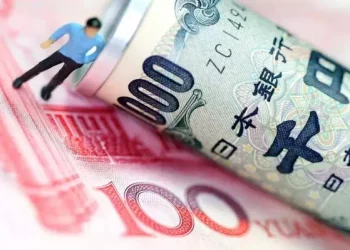The Indian Rupee (INR) experienced a sharp decline on Tuesday, wiping out all its gains for 2025. This depreciation follows escalating concerns over global trade tensions, particularly after China imposed retaliatory tariffs on U.S. goods. The rise in uncertainty has led to a shift in market sentiment, triggering outflows from emerging markets, including India, which has placed downward pressure on the Indian currency.
Multiple sources suggest that the Reserve Bank of India (RBI) may tolerate a steeper depreciation of the INR, especially if China allows its own currency, the Yuan, to weaken as part of efforts to mitigate the impact of U.S. tariffs. However, a broadly weaker U.S. Dollar, fueled by fears of a potential recession in the U.S., could help mitigate further losses for the INR.
Attention is now turning toward the RBI’s upcoming interest rate decision on Wednesday. Analysts are predicting a possible rate cut of up to 25 basis points, supported by easing inflation, as the central bank is expected to maintain an accommodative stance. Investors are also awaiting the U.S. Consumer Price Index (CPI) report for March, set for release on Thursday, which could influence future market movements.
HSBC’s Chief India Economist, Pranjul Bhandari, forecasts consecutive rate cuts from the RBI through its meetings in April, June, and August, suggesting continued support for India’s economy amid global uncertainties. Despite the challenges posed by trade tensions and tariff policies, government officials remain optimistic, projecting a growth rate of 6.3% to 6.8% for India’s fiscal year 2025-26.
Bond yields further dropped after the RBI’s announcement of another open market operation (OMO) in April, signaling its preference for maintaining ample liquidity to support economic growth. Radhika Rao, Executive Director and Senior Economist at DBS Bank, expects a 25 basis point cut in the repo rate to 6%, with an accommodative stance expected at the RBI’s April meeting.
Market expectations are growing for a potential Federal Reserve rate cut in May, with futures indicating up to 100 basis points worth of reductions by December. Federal Reserve officials have expressed concerns that retaliatory tariffs could drive up inflation and shift consumer behavior, adding to the global economic uncertainty.
On the foreign exchange front, the USD/INR pair is showing signs of an uptrend, with the price moving above the key 100-day Exponential Moving Average (EMA). If the upward momentum continues, USD/INR could test resistance levels at 85.88 and 86.48 before reaching the 87.00 mark. However, if bearish pressure continues, support is seen at 85.20, with potential for further declines to the psychological 85.00 level and beyond.
Related Topics:
























